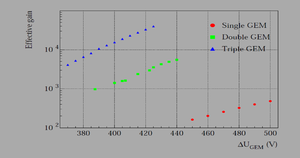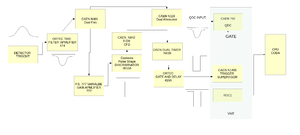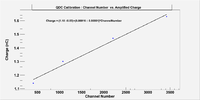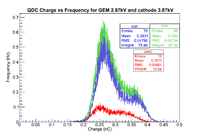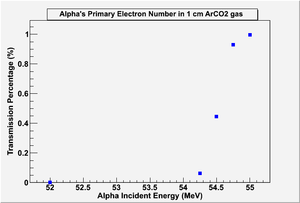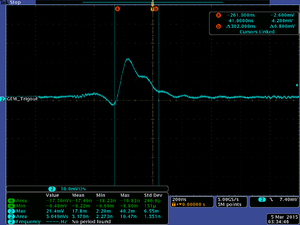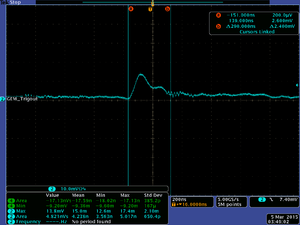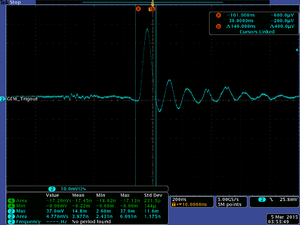Alpha Ionization
Alpha particles are highly ionizing and represents the main source for charge in QDC's charge spectrum. Alpha particles is mostly emitted by heavy radioactive nuclei, and it is energy is dependent on the mass difference before and after emission. For U-233, 85% of alpha particles has energy of 4.8 MeV when U-233 decays to an alpha particle and Th-231.
Primary and secondary number of electrons: references and simulations 02/26/15
First, the alpha emission rates were quantified according to their energy. Then a simulation was benchmarked with published data to determine the amount of primary ionization produced from a single alpha particle of a given energy. The ionization that takes place when the above primary electrons are accelerated in an external elective field was also simulated. The amplification of this ionization signal by the GEM foil preamplifier gain and the signal processing electronics was included to predict the ADC's response to an ionization event cause by the alpha particles from the embedded U-233 source. Finally, the impact of the shutter on the signal was predicted using a simulation.
- Alpha emission rates and their energies
A U-233 is a source of alpha particles was installed inside GEM detector. U-233 coated on the cathode of the GEM detector which separated with a drift area of 1cm. U-233 is an alpha emitter, the figure below shows the energy spectrum and the rate for each alpha energy,
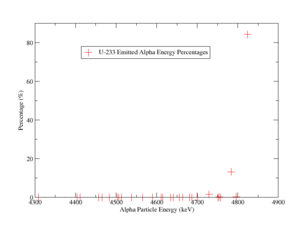 <ref>Akovali, Y. (1990, January 1). Table of Radioactive Isotopes. Retrieved January 1, 2014. </ref>
<ref>Akovali, Y. (1990, January 1). Table of Radioactive Isotopes. Retrieved January 1, 2014. </ref>
use Roy's measurement to convert above picture to absolute value of Hz
Alpha particles of an energy of 4.82 MeV has the highest rate of 85 percent compared to the other alpha energy's rate.
- Simulation benchmarks with published data to determine the amount of primary ionization produced from a single alpha particle of a given energy.
When an alpha particle travels in a pure argon, it liberates up to 30,000 electrons through primary and secondary ionization. <ref> Fabio, S. (2014). Basic processes in gaseous counters. In Gaseous Radiation Detectors: Fundamentals and Applications. Cambridge: University Printing House </ref> with without any electric field effect that may decrease the probability of electron-ion reattachment. On the other hand, Saito <ref> Saito, K., & Sasaki, S. (2003). Simultaneous Measurements of Absolute Numbers of Electrons and Scintillation Photons Produced by 5.49 MeV Alpha Particles in Rare Gases. IEEE TRANSACTIONS ON NUCLEAR SCIENCE, 50(6), 2452-2460 </ref> measured the number of primary and secondary electrons for a 5.49 MeV alpha particle, when about 4.7 kV/cm drift electric field collected the free electrons in the drift area to a collector, the number of collected electrons reached to 200k electron. Saito's measurements shows that the collector almost counts for all electrons, and a 1 kV/cm electric field decreases the probability of any electron-ion reattachment to increase the number of the collected electrons 8 times compared to that without the electric field.
Simulations of GEANT4 <ref> Agostinelli, S. (2003). Geant4—a simulation toolkit. Nuclear Instruments and Methods in Physics Research Section A: Accelerators, Spectrometers, Detectors and Associated Equipment, 506(3), 250–303 </ref> and Srim/Trim <ref>Ziegler, J. (2010). SRIM - The stopping and range of ions in matter (2010). Nuclear Instruments and Methods in Physics Research Section B: Beam Interactions with Materials and Atoms, 268(11-12), 1818-1823 </ref> were used to estimate the number of primary and secondary electrons for an alpha particle, both of the tools are able to calculate the number of primary and secondary electrons in a specific gaseous medium with a specific physical conditions for pressure, temperature, and density. The model in each tool was tested by estimating the range in Ar and CO2 gases, the results are shown below,
According to the figures above G4 succeeded to simulate the alpha range accurately in Ar and CO2 gas, but Srim/Trim model estimated the range with 50 percent less than that measured by Hanke and Bichsel <ref> Hanke, C., & Bichsel, H. (1970). Precision energy loss measurements for natural alpha particles in argon. Kbh.: Det Kongelige Danske Videnskabernes Selskab </ref>, also Srim/Trim estimated the same range of 4 cm for different alpha's energies.
G4 simulated the number of primary and secondary electrons in 1 cm of Ar/CO2 90/10 gas mixture, and the figures below show the results:
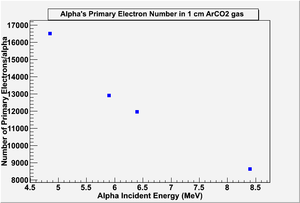
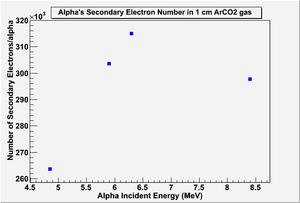 File:Excitation ionization ratio saito 2003.pdf
File:Excitation ionization ratio saito 2003.pdf
G4 estimated 2.7k secondary electrons when a 5.49 MeV alpha penetrated a 1cm of the same medium without any applied electric field, the estimation is close to Saito's measurements, which could be interpreted that G4 did not consider the reattachment of the electrons as they were collected in the drift area to end up counting for all the free electron in the gas. On the other hand, Scrim and Trim simulation for alpha particles ionizing a 1cm of pure Ar gas estimated about 1 MeV deposited energy in the medium within that distance, it made the final number of electrons around 37.5k electron (considering w = 26.7 eV/ip), which the same estimation mentioned by Sauli.
- The amplification of this ionization signal by the GEM foil preamplifier gain and the signal processing electronics was included to predict the ADC's response to an ionization event cause by the alpha particles from the embedded U-233 source
Garfield <ref> Garfield++. (n.d.). Retrieved June 1, 2013. </ref> is used to simulate the electron multiplication in Ar/CO2 gas in GEM based detectors. Garfield simulated a triple GEM detector gain of 200 eV electron that passed through a 1cm drift area of an electric field of 1-4kV/cm. The readout collected 8 +_1 electrons for each incident electron by he end of the drift area, such a result explained increasing the number of alpha's electrons by ionization to 200k electron <\Saito>, as the free electrons travelled through the drift area, a multiplication of order of 8+_1 electrons was generated by accelerating the incident electrons by the 4.7 kV/cm drift electric field, by dividing 200 k electron by 8, the result was 25k electron is the number for each alpha particle before multiplication, and it is within the same order as one predicted by Scrim/Trim and Sauli.
Garfield was also used for simulating the electron multiplication by triple GEM detector. Garfield is well-known in simulating the interactions in gaseous media such as electron multiplication, it is also supported by scripts to help in simulating different interactions. One of the scripts was used to simulate triple GEM detector multiplication after testing the the script output by simulating the triple GEM gain that is shown below,
Garfield simulated the gain when the voltage for each GEM detector is 466V in average, the gain is 1.1617 x 10^4 +_1099 for 293k and 1021 Pa.
In our case, by the end of the drift area, the electron will have 3 stages of multiplication by GEM preamplifiers, the voltage on the potential divider circuit is 2800 kV, which will provide 300-350 V on each GEM preamplifier. Garfield succeeded to simulate the gain for 2.8 kV triple GEM in Ar/CO2 90/10 gas mixture under STP conditions of an average value of 7.88 +_ 2.8 x 10^3. So, the charge collected by the charge collector for 4.82 MeV alpha particles is expected to be:
The figure below shows the signal processing electronics configuration,
A signal of an amplitude 11.8 mV passed through the loop to output a 20.8 mV amplitude signal as shown by a 50 ohm terminated oscilloscope, using the figure below, the amount charge that ADC collected is,
- FR4 Shutter Effect
A 1 cm FR4 shutter stops all Alpha particles that are emitted from U-233, the following figure shows the percentage of the number of alphas that penetrate the shutter,
For a complete penetration, alpha's energy has to be around 60 MeV. It is Previously mentioned that the emitted alpha particles from U-233 has a maximum energy of 8.4 MeV, So the shutter is able to stop all the emitted alpha particles without any scintillation. The simulation result agrees with Saito's experiment which confirms that travelling in a 1cm argon gas with 4.5 kV/cm electric field is one of the ways to study alpha's scintillations.
03/05/15 Measuring the GEM charge from the oscilloscope
A 50 ohm terminated oscilloscope measured the pulse that comes directly from the tripe GEM trigout as the voltage 2.8, 3.8 kV for the triple GEM and the cathode successively, the triangle pulse amplitude is 19 mV, and it width is 299 ns, if the pulse represents an alpha ionization, then the number of alphas considering the charge received directly from the trigout is,
Also the number of alphas for the second figure is 1.6, and for the third one is 2.1.
alpha particle simulation related
<References/>
GO BACK [1]


